One of my favorite things about living in Southern California is that I can grow so many incredible things in my small, backyard garden, include a variety of herbs. But, what are the best herbs to grow in Southern California?
Luckily, most of the herbs we use regularly are quite easy to grow in California. Why spend a ridiculous amount of money to pick up a small pack of fresh herbs from the grocery store when you can simply snip off what you need from a plant in your yard or on your patio? Plus, fresh herbs just taste better.
Here are the best herbs to grow in Southern California, along with tips on how to grow them, when to plant them, and which varieties to plant.
Best Herbs to Grow in Southern California
Sage
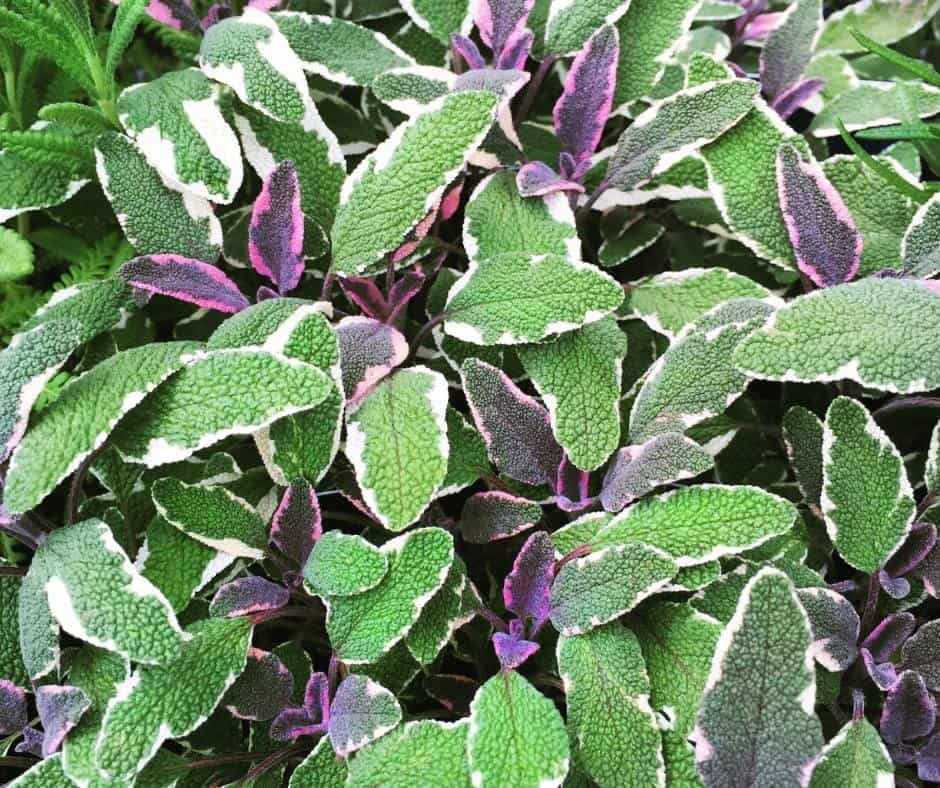
When to plant sage in Southern California: Spring or fall are ideal, but you can really plant it anytime in SoCal.
Recommended varieties of sage for Southern California: I like the look and taste of tricolor sage. Leaves are silvery-green and white with purple leaves intermixed, and lavender flowers. Of course, regular culinary sage you will find at any nursery does the job, too.
Sage is easily the most common native herb growing throughout California. As a matter of fact, there are 118 varieties of sage that grow throughout the state. I think every Southern California garden should have at least one sage plant.
Sage is commonly used in savory poultry dishes, and is one of the most distinctive flavors in your Thanksgiving stuffing. It is also a common herb in many soups and stews.
Sage is a perennial plant, meaning that it does not need to be planted annually. As long as it receives a good amount of sun and some water, and is in well-drained soil, it should do well year after year. Sage plants vary in size, but most culinary sage plants are about 1.5 feet tall and wide.
If you have a patio garden, sage will do well as a container plant, provided you keep it in a pot that drains well and give it some sun.
Sage is not usually grown from seed. You can either propogate sage from cuttings or keep things easy and just purchase up a small plant for a few dollars. Sage is typically available for purchase at plant nurseries and home improvement stores year round.

If you are looking for another interesting variety to grow, try pineapple sage. This plant can get up to four feet in size, has lovely red flowers in the late summer/early fall, and a wonderful pineapple scent.
Pineapple Sage is a great addition to a butterfly garden. It is also edible and is mainly used as garnish or in salads and teas. The flowers are edible as well.
How to harvest sage: The best way to harvest sage is to simply snip what you need as you need it. You can also harvest and dry sage to preserve it for future use.
Rosemary
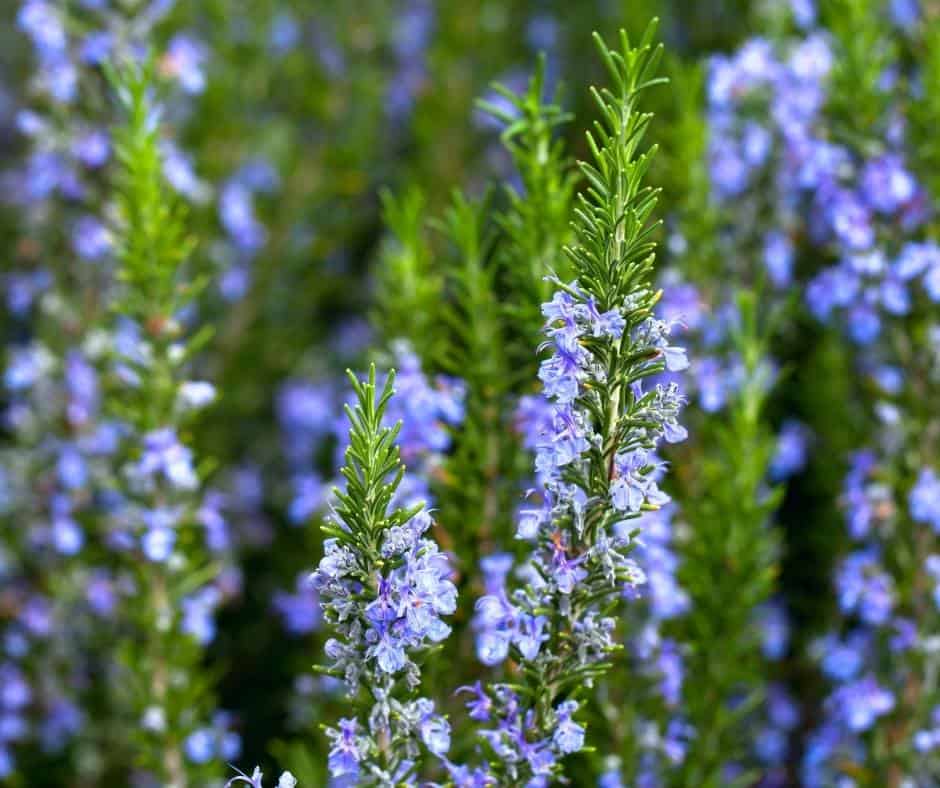
When to plant rosemary in Southern California: You can plant rosemary year round, but the best time is spring. If you live in an area that receives frost, wait until two weeks after the last frost.
Recommended varieties of rosemary for Southern California: Tuscan Blue is a nice upright variety of rosemary that grows very well in SoCal. It also has good culinary flavor.
Rosemary is another herb that grows extremely well in Southern California and is commonly spotted in yards across the region. If you walk your neighborhood, you will probably see several neighbors who have rosemary shrubs in their front yard.
It is a woody, evergreen shrub that is hardy and can get quite large, up to five feet in height in diameter (or bigger!), so regular trimming is recommended if you don’t want it to get that big.
It can also grow well in containers which will help keep its size in check. There are even trailing varieties of rosemary that are used for groundcover. Rosemary can become fairly drought tolerant once established, another reason to have this herb in your Southern California garden.
When rosemary blooms, it typically has cute little blue flowers, but there is a variety that produces pink flowers- Majorca Pink. Bees love rosemary, making it a nice addition to a pollinator garden. It does well in full sun or part shade.
Rosemary is used in a variety of soups, casseroles, chicken and meat dishes. It can be used fresh or dried. It also makes for a lovely garnish.
Rosemary is not grown from seed. You can either propogate rosemary from cuttings or purchase a rosemary plant from the nursery.
Propagating rosemary is easy. Place 6″ cuttings with the lower leaves stripped off into a couple inches of water. Change the water regularly. Once you have a good amount of root growth you can move your cutting into well-drained soil and it should do great from there.
Lavender
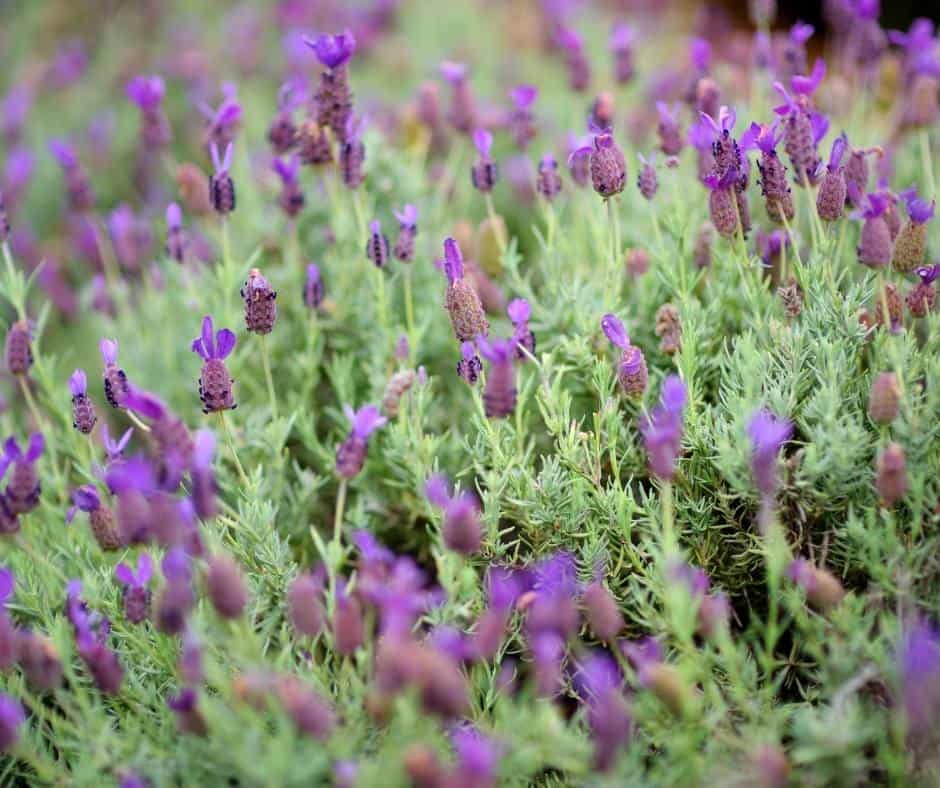
When to plant lavender in Southern California: Late fall or spring.
Recommended varieties of lavender for Southern California: French Lavender is a pretty variety with big showy flowers and silvery green foliage.
Lavender has become a mainstay of drought tolerant landscapes across Southern California. As more and more people replace their lawns with low water plants, lavender is quickly becoming one of the most common plants in Southern California gardens, thanks to its hardiness as well as its lovely foliage, flowers, and scent.
Lavender originated in the Mediterranean region of Europe, which has a similar climate to California, so it is no wonder that it does so well here. Lavender only needs to be water regularly when first planted or during a heat wave. Overally, it is very hardy.
There are several varieties of lavender that do well in our neck of the woods, including French Lavender, English Lavender, and Spanish Lavender.
Interestingly enough, what we call French Lavender in the USA, Lavandula dentatam, is what the French call English Lavender.
Honestly, as long as you buy your lavender plant locally, it should do well. Most people start lavender in their gardens by picking up a little plant at their local garden center and the good news is that most garden centers tend to carry varieties that are suitable for your climate zone.
In order to keep your lavender plant producing lots of healthy flowers you should deadhead (garden lingo for remove the dead flower) dried, dead flowers from the plant.
Check out this amazing lavender farm you can visit in Southern California just outside of Temecula.
Most people harvest lavender by snipping off several stems with flowers and then hang them upside-down to dry out. This herb is primarily used for its calming and lovely scent, and dried lavender is commonly placed in sachets or bouquets around the home.
Lavender is also edible, but not as widely used in recipes as most of the herbs on our list. English Lavender is the most widely used culinary version of lavender. Here is Martha Stewart’s compliation of lavender recipes.
Basil

When to plant basil in Southern California: Early spring. If you experience frost where you live, plant after the last frost.
Recommended varieties of basil for Southern California: Genovese or Sweet Basil is the best for pestos and tomato salads. Thai Basil is a great addition to Asian dishes.
If I had to choose a favorite herb to grow in Southern California, it would probably be basil. It is a mainstay in my garden and it just compliments all the tomatoes I grow every year so perfectly.
If you want to grow tomatoes in addition to your herbs, definitely check out my tomato planting tips as well as my tomato growing tips. You will be blessed with a bountiful harvest if you follow my secrets!
Basil is one of my favorite herbs to cook with, and homegrown pesto sauce is something that has to be tasted to be believed. One basil plant is enough to keep my family happy with tomato/burrata salads and pasta with pesto all season long.
Plus, if I harvest basil regularly, I can quickly make and freeze pesto to enjoy in the winter as well. My basil plant has to be cut back almost completely at least once a season when it gets too woody and the leaves grow sparse, but it always comes back with a vegeance.
Basil likes regular watering, and does especially well when watered via a drip system. Still, you can grow it in pots and water overhead, just be sure you keep the soil moist. Basil will wilt quickly if it is neglected.
It is also important to keep pinching off the basil flower buds as they appear, so the basil plant won’t bolt, go to seed, and get super leggy. You will end up pinching off flowers almost daily in the peak of summer but it only takes 30 seconds to keep your plant happy. I tend to plant my basil alongside peppers because they have similar needs.
I have had basil plants overwinter here in Orange County, but I think you are better off pulling the plant out of your garden in late fall and replanting again in the spring.

If you cook a lot of Asian food, then a Thai Basil plant is a nice addition to your garden. The leaves are smaller and it has a spicier flavor with hints of anise. Thai Basil tends to hold up better in cooked dishes.
Basil can also be dried and stored for culinary use, but fresh basil is so much more flavorful.
Basil can be grown from seed (typically indoors first and then transferred outside), but basil plants can be commonly found in garden centers, nurseries, and even grocery stores. Baker Creek Heirloom Seeds has some really interesting varities of basil than can add some pizzazz to your herb garden.
Oregano

When to plant oregano in Southern California: Spring
Recommended varieties of oregano for Southern California: Origanum Vulgare aka: Greek Oregano is the standard. Mexican Oregano is also worth planting if you cook lots of Mexican food, especially soups.
Oregano is an essential ingredient to many Italian dishes, and is commonly used in pizza and pasta sauces. Since it is a Mediterranean herb, it does very well in Southern California.
Oregano is quite drought tolerant and is an attractive addition to a garden that reflects Southern Claifornia’s dry climate. It does well in containers, hanging planters, and in the ground. It prefers sun and well-drained soil. Allow soil to dry in between waterings.
Oregano is a good herb to plant near members of the cabbage family because it helps repell those pesky cabbage moths naturally.
You can grow oregano from seed or purchase a plant from your local nursery. Oregano seeds are tiny and don’t need to be buried. they can be simply sprinkled on top of soil and watered. It is easier to start the seeds inside and the transfer your seedlings once established.
This herb is perrennial in the regions of Southern California that don’t receive frost. It may die back some in the winter, but it will return. If you do receive frost, you will likely have to treat oregano as an annual.
Oregano can be used fresh in your dishes or dried and saved for future use. It holds its flavor well. In addition to pasta sauce and pizza, oregano is commonly used in soups, casseroles, chicken and fish dishes, and even pesto.
Greek Oregano is the most commonly used oregano variety in the US. Marjoram is actually a variety of oregano. It tends to be similarly flavored but less spicy than Greek Oregano.
Italian Oregano is very similar in flavor to Greek Oregano but is less bushy. I like growing it in my hanging garden because it has delicate, long stems filled with leaves and tiny white flowers.
Mexican Oregano is actually a different genus and species than the related Greek and Italian strains. It is a popular herb to use in cooking Mexican dishes and loves the heat. It’s flavor is bolder and stronger than Greek Oregano.
Cilantro

When to plant cilantro in Southern California: During the cool seasons when there is no danger of frost.
Recommended varieties of cilantro for Southern California: Leafy varieties like Leisure or Slo Bolt. Coriandum Sativum is the most common species.
As someone who loves Mexican food and makes lots of salsa, I have a love/hate relationship with cilantro. I love the flavor and convenience of fresh cilantro but I hate how quickly it tends to bolt (go to seed) in my garden.
Cilantro is one of those herbs that you just have to keep planting in order to enjoy it for more than a month or two at a time. Since it does grows very easy from seed, this isn’t a hard thing to do, you just have to remember to do it!
Plant new seeds every two weeks so that as one cilantro plant starts to bolt, the next plant will be ready to harvest. You can’t really prevent a cilantro plant from bolting, and once the plant does start producing its white flowers, the leaves begin to lose flavor.
Cilantro does best in cool, but not cold weather. In Southern California that is generally late winter/early spring, as well as later in the fall. It does like sun and moist soil, but part shade will work if you are trying to grow cilantro in warmer weather. You can also grow it indoors in a sunny window during the warmer months to keep it from bolting so fast.
If you plant cilantro in the ground, it can definitely self-sow, aka: drop seeds into the ground which will produce new plants next year. You can purchase cilantro plants from nurseries, but it is much more economical to grow it from seed since they don’t last as long as other herb plants.
The best way to harvest cilantro is to clip what you need as you need it, and use this herb fresh. It is delicate and doesn’t really hold up well to drying.
Coriander, a popular spice used in curry and pickling, is actually the seed of the cilantro plant. You can harvest and dry our these seeds for culinary use.
Parsley
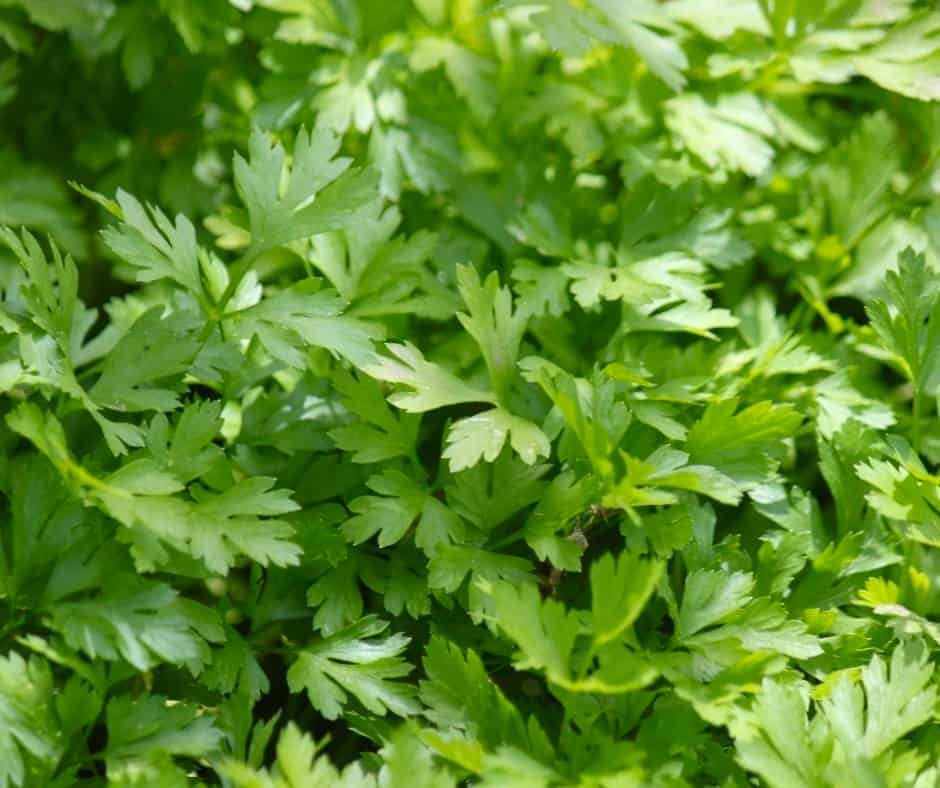
When to plant parsley in Southern California: early spring is ideal
Recommended varieties of parsley for Southern California: Flat leaf Italian Parsley
I have found parsley is a herb that grows very well in Southern California. As a matter of fact, I have been surprised by just how big a parsley plant can get (up to 3 feet tall and 2 feet wide) when it is happy in a raised bed garden. One plant has always suited my family’s needs, but if you use parsley more frequently feel free to plant more.
I tend to only grow Flat Leaf Italian Parsley because it has a superior flavor and more uses than Curly Parsley. Curly Parsley is most commonly used as a garnish, but it is also good to chew on to freshen your breath after a meal.
You can grow Flat Leaf Italian Parsley year-round in portions of Southern California that don’t receive frost, but I do like to replace my plants once a year.
Grow parsley from seed or buy a little plant at the nursery. Seeds should be sprinkled on garden soil and covered with just a quarter inch of soil. Soil should be kept moist while the plant is germinating. I also recommending keeping your parsley plant mulched to keep the moisture content in the soil even.
Parsley will also grow well in containers as long as it is watered regularly and its roots have room to grow (ideally 8-10′).
Harvest parsley as needed, snipping off the plant at least 2″ above the base. Cut back the plant when it starts to get leggy or flowery, and it will regrow new leaves.
Dried parlsey is okay, but not nearly as good as fresh. You can freeze also parsley in ice cube trays for long term storage. Parsley is a nice pesto option as well.
Thyme
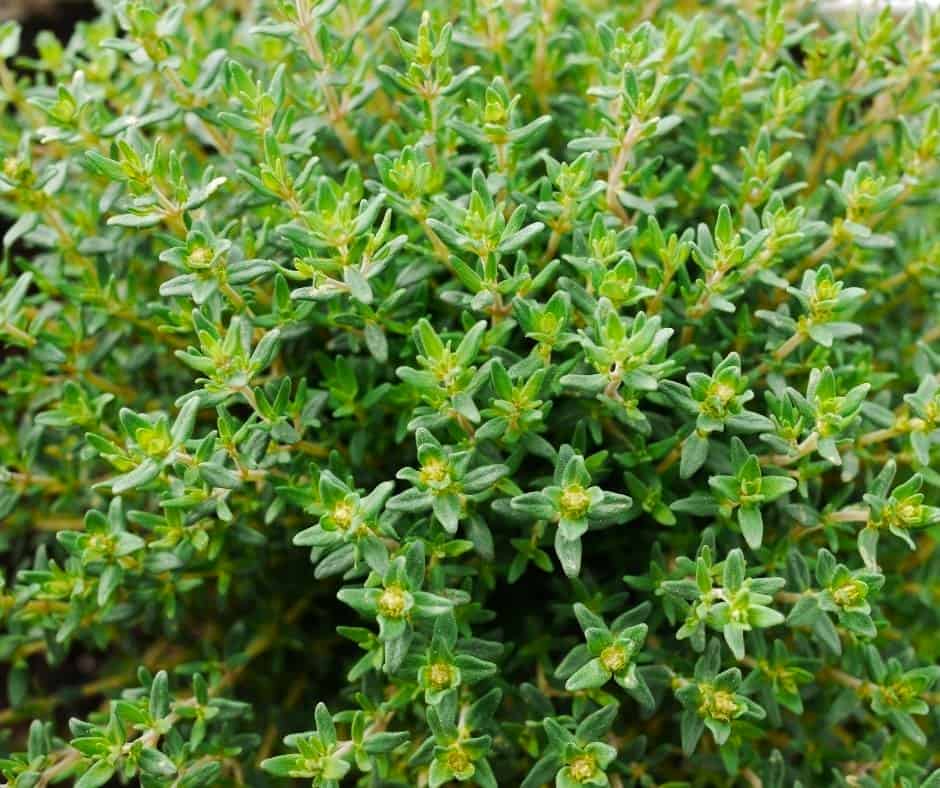
When to plant thyme in Southern California: fall or spring
Recommended varieties of thyme for Southern California: English Thyme aka: Common or Culinary Thyme is the standard. You can also try Lemon Thyme for citrusy twist on your thyme’s flavor.
Thyme is yet another herb that loves Southern California’s climate. It is evergreen and does well when it receives full sun and is planted in soil that drains well. It is also very successful as a container plant. Don’t over water it, but keep in mind that containers do dry out quicker.
Thyme does well in full sun but can also do just fine in part shade in the hotter portions of Southern California.
There are varieties of thyme that are low growing and used for ground cover. They are very lovely to look at and are edible, but they aren’t ideal for cooking because they don’t have as good of a flavor.
The taller varieties are better for adding to your recipes. Taller varieties are still not super tall, just 12-18 inches high. Thyme does benefit from mulching and seems to like rock mulch best but will be fine with traditional bark mulch as well.
Thyme can be grown from seed, cuttings, or purchased as a little plant from your local nursery. Thyme is easy enough to grow from seed but can take up to four weeks to germinate, so I tend to just go the easy route and buy a little plant.
Thyme is used in a wide variety of dishes including soups, chicken, potatoes, and casseroles, so having a plant on hand to quickly snip a sprig as needed is convenient and cost effective. Fresh herbs from the grocery store tend to be expensive.
Thyme is best used fresh, but it does hold up well to preservation. It can be preserved in olive oil, frozen in ice cube trays, or dried.
Bay Leaves

When to plant bay leaves in Southern California: fall or spring
Recommended varieties of bay leaves for Southern California: Just go for the traditional Bay Laurel, aka: L. nobilis.
Ten years ago when I took a trip to Italy, I saw hedge after hedge with very familiar looking leaves. Some were potted, others were grown as privacy hedges. I asked my guide and he did, in fact, confirm that I was looking at Bay Laurels. These hedges produce bay leaves, a staple in countless soups and stews.
As soon as I got home I immediately decided I needed a potted Bay Laurel on my patio. After all, if it was growing with ease in Rome, it was going to do well in Southern California’s Mediterranean climate. So I purchased a 10 gallon pot, planted my little Bay Laurel, and that is where is has been ever since.
My Bay Laurel has survived neglect by house sitters on more than one occassion. It likes to be watered once or twice a week, but it will hang tough for much longer. Whenever I need a couple leafs for soup, I just pluck them off, give them a quick rinse and add them to the pot.
You can plant Bay Laurels in the ground but they will get very tall (up to 50 feet in the wild) eventually. They do grow slow (only a few inches per year) and their size can be managed with trimming. They can also be shaped into topiaries is you are so inclined, or used as privacy hedges.
Bay Laurels are difficult to grow from seed but you can grow them from cuttings or just simply pick up a plant from the nursery.
Love patio trees? Check out our picks for the best container fruit trees for your patio.
Chives
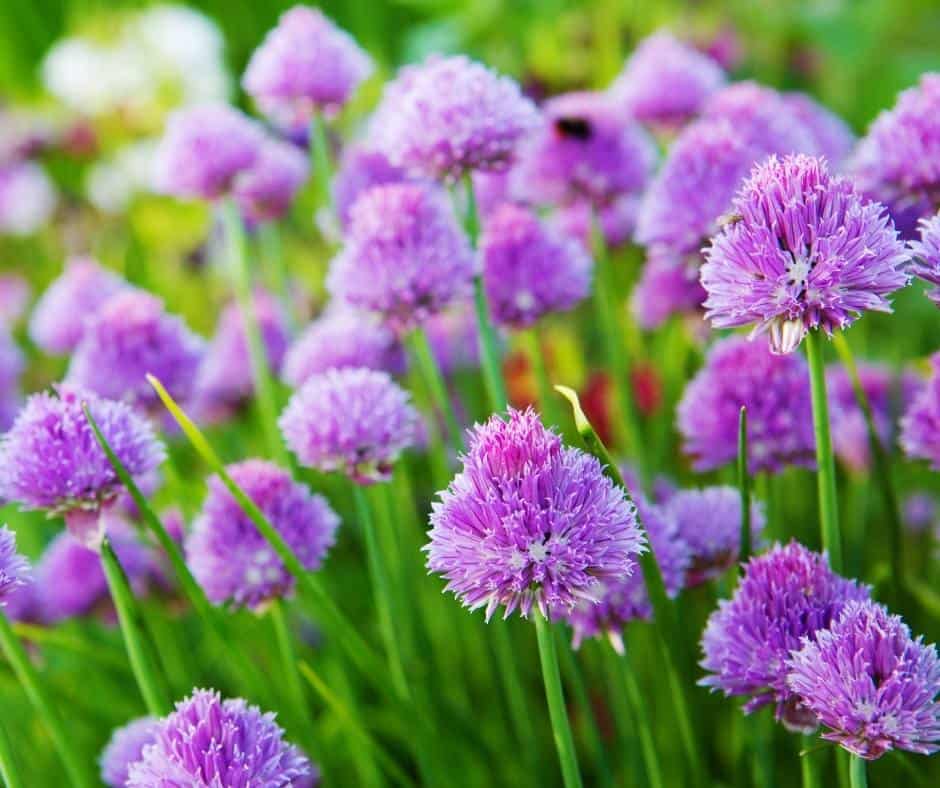
When to plant chives in Southern California: early spring
Recommended varieties of chives for Southern California: Common Chives or Garlic Chives. Personally I like to have both options growing.
I simply love the purple pom pom flowers of a chive plant. They are so delicate and beautiful, and a nice addition to salads. Flowers can also come in pink or white in common chives, and are white in garlic chives.
Use chive leaves in any dish that you would like to add mild onion flavor. I especially enjoy them diced up in dips, added to a compound butter, or atop a baked potato.
Chive plants love full sun and plenty of water. They are great companions to tomato plants because their scent helps ward off pests. They can also do well in containers as long as you water them regularly. They are small and only reach between 10-20 inches in height.
Chives prefer cooler weather and the heat of the summer may kill them off, but it you leave the bulbs in the ground they should reappear in the fall. If you keep your chive plants for a couple years, the bulbs will eventually need to be dug and up and divided in order to keep them producing well.
You can either purchase little chive plants from the nursery or grow them from seed. Seeds should be planted about two inches apart and lightly covered in just a quart inch of soil. It can take a couple weeks for the seeds to germinate.
Chives are best used fresh, but can be frozen for future use. Drying chives causes them to lose their flavor and is not recommended.
Tarragon
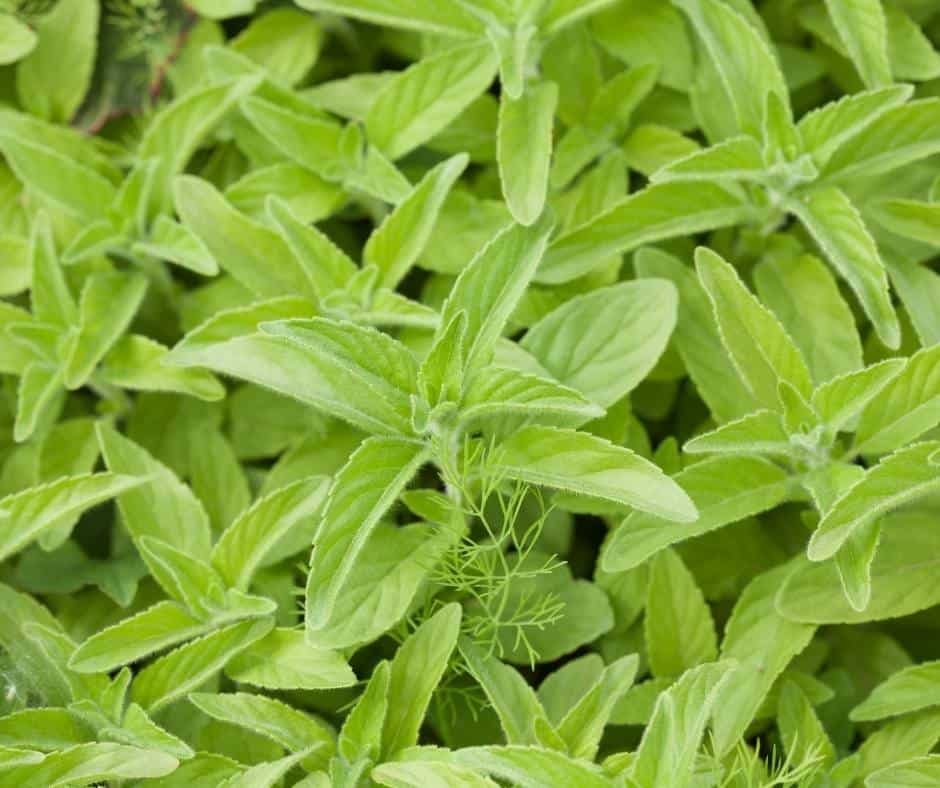
When to plant tarragon in Southern California: spring
Recommended varieties of tarragon for Southern California: French Tarragon is the variety commonly used in cooking.
Tarragon is not the most popular herb around, and it isn’t the most ornamental, but it is actually a great addition to any kitchen. Having fresh tarragon around is a treat, especially to anyone who enjoys cooking class French dishes.
It is most often used in fish and chicken dishes. as well as a variety of sauces and salad dressings. Tarragon has an anise flavor, with hints of dill and floral undercurrents. It is a distinct and aromatic herb.
Fremch Tarragon does not grow from seed, so it is best to just pick up a little plant from your local nursery. It is easy to grow- just plant it in full sun to part shade and make sure the soil drains well. Tarragon is a great addition to a raised bed or can be grown in a small container.
Tarragon leaves can be harvested at any time, but have the best flavor before the plant puts all its energy into flowering.
You can dry tarragon and it will hold on to its flavor well, similar to oregano. The best way to dry tarragon is to bundle the leaves and hang them upside down in a dark space for several days.
Fennel
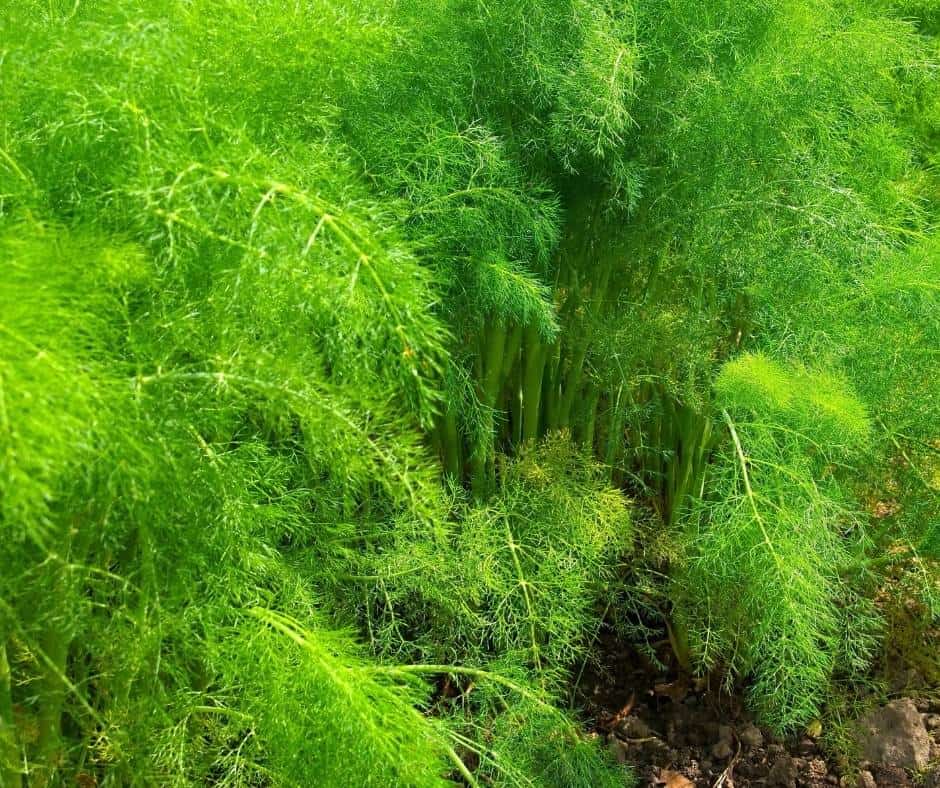
When to plant fennel in Southern California: early soring or early fall.
Recommended varieties of fennel for Southern California: Grosfruchtiger as an herb fennel. Florence Fennel if you are more interested in harvesting the bulb.
Fennel is a beautiful herb. It has delicate, fern-like leaves and a wonderful, bright green color. It is closely related to carrots, and it you can certainly see the relation between carrot tops and fennel fronds.
Fennel actually grows wild in Southern California, especially in areas close to the coast, and is seen as an invasive species since it is native to Europe. Wild fennel is basically the same as the type you grow for culinary purposes, except it doesn’t usually have a big bulb. Still, the leaves and seeds are edible.
You can plant fennel in the ground, in raised beds, or in a container. It will be happy as long as it gets six hours of sun and has well-drained soil. It is quite drought tolerant, but does need some water occasionally once established.
There are many parts of the fennel plant that have culinary uses. The leaves, seeds, and bulbs are all used in dishes and have a sweet anise flavor. You can even use the flowers in salads. Techincally speaking, the leaves, seeds, and flower are considered an herb and the bulb is a vegetable.
Fennel is best grown from seed. Seeds should be planted about a half inch deep and kept moist. They will germinate in 1-2 weeks. You can also purchase a small fennel plant from your local nursery and transplant. Just take care not to disturb the roots too much.
Fennel grows as a perrenial plant in California, but should be replaced every couple years because they start to lose their pizzazz a bit.
The fennel stems, bulbs, and flowers are best eaten fresh but the seeds can be dried and stored for future use. Seeds can be harvested in late summer or early fall when they start to turn brown.
Clip the flower heads and place them on a tray in a dark place for a couple weeks to dry. Then shake out the seeds and store them in an airtight container.
Mint
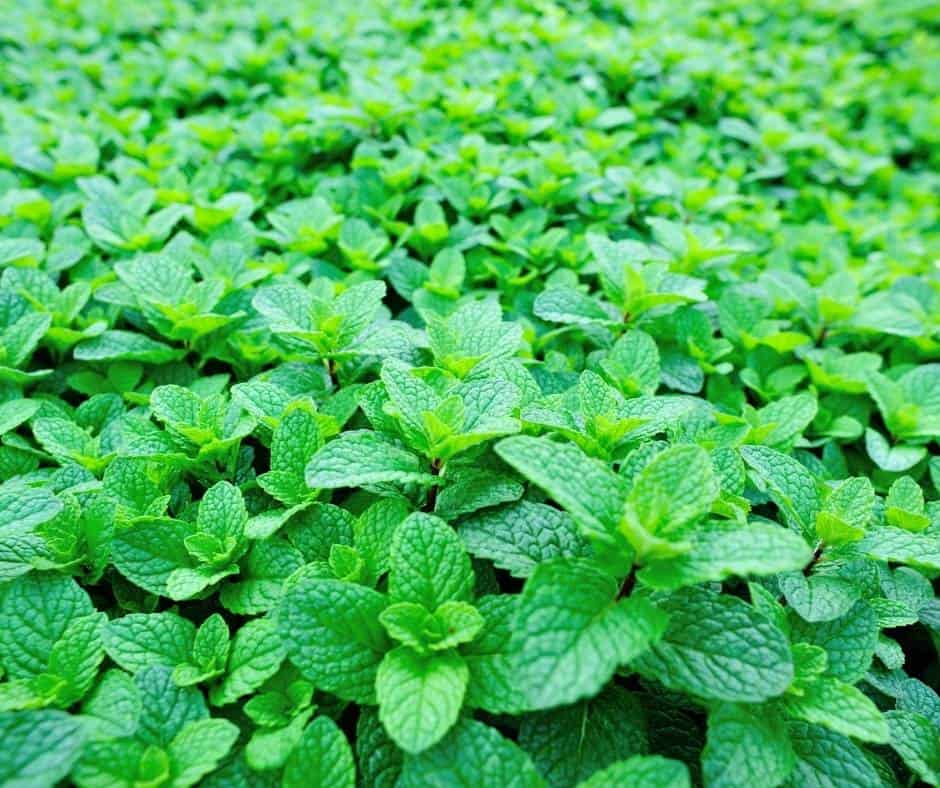
When to plant mint in Southern California: Year round but ideally spring or fall.
Recommended varieties of mint for Southern California: Spearmint and Peppermint are classics, but I also can’t resist Chocolate Mint or Pineapple Mint.
Having fresh mint around to add to tea or a cocktail is truly a delight. And there are so many fun varieties to choose from with distinct flavors and scents.
Mint is one of those herbs that grows almost too well, and can easily take over your garden if you don’t contain it. As a matter of fact, once you plant mint somewhere, good luck every getting rid of it! This plant will put down runners underneath the soil and spread anywhere and everywhere it can.
For this reason, I implore you to grow mint in a container. You can submerge the container into the your garden soil to make it look like the mint is planted in the ground, but it is so important that you keep those roots contained. The top of the container should be at ground level so the roots can’t get out.
I like to just keep a couple different mints in pots around my garden. Mint does prefer morning sun and afternoon shade, so place your pot of mint in a spot that will suit its needs. It should be watered regularly as mints like moist soil.
Mint is perennial and will even tolerate frost, so as long as you don’t let it dry out, your mint plant should thrive for a long time.
Mint is typically purchased as a plug tray or small plant. A well-stocked nursery has several distinct smelling varieties like Chocolate Mint, Pineapple Mint, or Apple Mint, as well as classics like Peppermint and Spearmint. It can also be grown from seed.
Harvest mint as needed, by pinching off a few leaves at a time. You can also preserve mint by freezing the leaves either whole or chopped.
Lemongrass

When to plant lemongrass in Southern California: In spring after the danger of frost has passed.
Recommended varieties of lemongrass for Southern California: The standard is Cymbopogon citratus for culinary uses.
Lemongrass is an essential herb in Asian cooking. It has a bright and fresh citrusy flavor and refreshing scent.
Luckily, lemongrass grows well in Southern California, especially in places that get lots of heat. It is native to areas of Sri Lanka and India that are warm and wet, so you will need to keep it well watered and make sure the roots don’t dry out.
Lemongrass is a nice ornamental grass and grows in a clump that is 2-4 feet tall and 2-3 feet wide. It is a perennial in portions of Southern California that don’t receive frost. Plant lemongrass is the hottest, sunniest spot in your garden.
In addition to being a great herb for culinary use, it is also a good mosquito repellant. If you overwinter your lemongrass, trim it back to six inches in height. It will grow new shoots in the spring.
Lemongrass is easy to grow from seed but is more commonly purchased as a small plant from a nursery. Like many other ornamental grasses, you can dig up the clump and divide and replant in to order to increase your lemongrass supply.
Lemongrass is typically grown in the ground but will grow in pots as long as they are at least five gallons in size and well watered.
Lemongrass leaves can be bundled and steeped in teas but are too fibrous to be edible. The edible portion of lemongrass is at the bottom of the stalk.
The outer layer needs to be peeled to reveal the white stalk which can be sliced and diced to eat. Just be careful because the leaves of lemongrass can be very sharp!
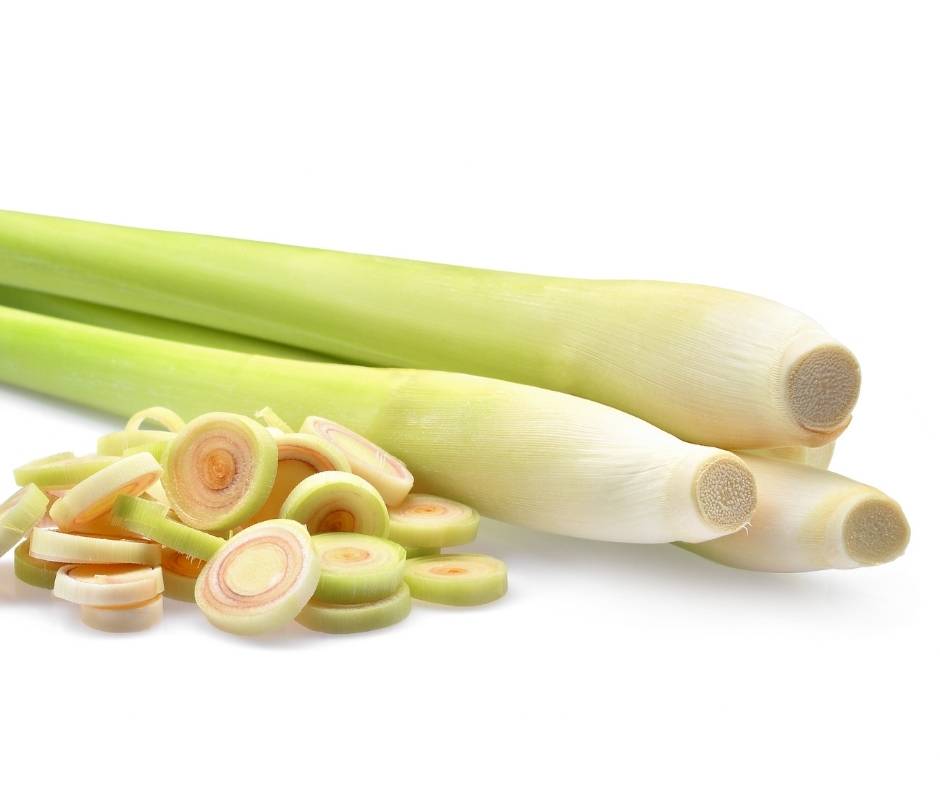
The portion of the lemongrass base that is edible can be frozen for later use. The grass should be used fresh.
Arugula

When to plant arugula in Southern California: Pretty much year round as long as there is no frost. It does best in spring and fall.
Recommended varieties of arugula for Southern California: Red Dragon is a beautiful addition to a salad with its red streaks along the stem. Standard Arugla (Rocket) is always a good choice as well.
Arugula is probably my favorite herbal addition to a salad. It has this peppery, mustardy bite that I just can’t get enough of. Arugula is incredibly easy to grow at home and if you grow it in two week successions you will have arugula to harvest all season long.
Arugula originated in the Mediterranean portion of Europe so it is no surprise it does well in Southern California. Arugula ideally grows in full sun most of the year, but can benefit from part shade in the warmer season so it won’t bolt as quickly.
Fun fact: Arugula is known as “rocket” in Europe.
The seeds are easy to germinate– sprinkle several in a small area and cover with just a quarter inch of soil. In just a week sprouts will begin to appear. Plant your seeds in a raised bed or container. You can grow it directly in the ground as well, provided you have decent soil.
Harvest your arugula when stems are about 2-3 inches tall. This will take about 4-6 weeks from seed planting. If you let them grow too big they will get tougher and more bitter.
Arugula is a great salad herb but it is also a welcome addition to pizzas, sandwiches, in egg dishes, and as a pesto.

